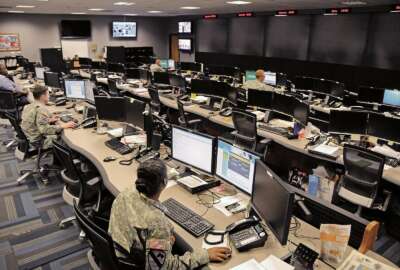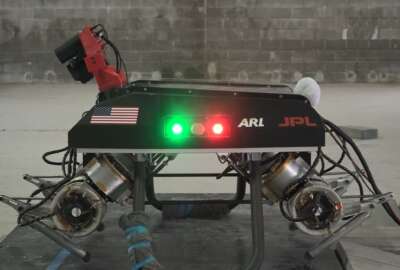
NDAA requires Pentagon to secure circuit board supply chain
Nearly every military system runs on software. Now the National Defense Authorization Act requires the Pentagon to take steps to ensure security of its supply chain...
Best listening experience is on Chrome, Firefox or Safari. Subscribe to Federal Drive’s daily audio interviews on Apple Podcasts or PodcastOne.
Nearly every military system runs on software. But software runs on hardware, and hardware is made up of printed circuit boards. Now the National Defense Authorization Act requires the Pentagon to take steps to ensure security of its supply chain of circuit boards. With what this all means, the vice president for government relations at the Institute for Printed Circuits (IPC), Chris Mitchell, spoke to Federal Drive with Tom Temin.
Interview transcript:
Tom Temin: Mr. Mitchell, good to have you on.
Chris Mitchell: Thank you Tom for having me.
Tom Temin: First of all, tell us what is in the NDAA that relates to printed circuit boards of all types and what does it require the Pentagon to do so far as we can tell?
Chris Mitchell: Section 841 of the NDAA is a major legislative achievement for the industry, and an important first step in helping to establish a trusted supply chain for print circuit boards and for bare and assemble printed circuit boards. So the Section 841 does a few a few things. First of all, it bans the sourcing of defense electronics from China, North Korea, Iran and Russia, effective January 1, 2023. Number two, it directs the Defense Department to engage one of the federally funded R&D centers to study the inclusion of COTS electronics, commercial off the shelf electronics, into restrictions that might be implemented in the future. And finally, it extends Section 224, trusted supplier requirements for micro electronics to printed circuit boards and printed circuit board assemblies. And so again, we see this as an important first step in really establishing a community of trusted suppliers here in the United States and among our allied countries for the manufacturer of printed circuit boards and printed circuit board assemblies.
Tom Temin: Now there’s a big difference between a bare board and a populated board that has the circuitry on it. Is there a supply chain, some sort of cybersecurity danger or other danger from bare boards that might come from suspect countries?
Chris Mitchell: Sure. And I want to make clear that the Section 841 provision of the NDAA does apply to both printed circuit boards and bare printed circuit boards and assemble printed circuit boards. But you’re absolutely right, there are significant security concerns related to assembled printed circuit boards. I will say is that I think historically we have underappreciated some of the security challenges related to printed circuit boards. And for those who are not familiar with printed circuit boards, we commonly think of them as the green boards that you might find inside your electronics. Well, really what those boards do is, number one, they provide structure for the electronics. But number two, they electronically connect the components that sit on top of that board or are embedded within the board. And as these printed circuit boards have become, have had to accommodate increasingly sophisticated miniaturized components, the boards themselves have become exponentially more sophisticated as well. When you think about these security concerns, you can really categorize them into four categories. The first relates to malicious insertion of components onto those boards. It’s not an easy task, but there is evidence suggesting that adversaries are exploring and even undertaking this malicious insertion of components onto these boards that would allow those adversaries either to undermine the performance or sabotage the performance of those boards. Number two, quality, again, a half cent capacitor that’s misplaced on a board can bring down a $300 million satellite system. And so we need to make sure that the quality of these boards is high. And again, that requires reliance on a trusted supply chain. Number three, IP theft. The fact of the matter is to manufacture a printed circuit board, you need to have pretty good knowledge of the working of the workings of the end system. And so to the degree that we are manufacturing boards elsewhere around the world, that does open up concerns around IP theft. And then finally, resiliency of our overall electronics manufacturing ecosystem. But we have seen a real contraction, especially in the number and overall market size of printed circuit board manufacturing here in the United States. We believe that this is the result of a kind of benign negligence toward PCB manufacturing here in the United States. And we need to address that so that we can make sure that going forward we have a more resilient ecosystem for for that manufacturing.
Tom Temin: And let me just ask you one detailed question before I get into the bigger question of the supply in the United States. As you mentioned, the surreptitious insertion of a component in an otherwise bare board could be a problem. Boards today are multi layers, at one time a printed circuit board was one layer, so you could see something either on the top or the bottom. Now, they may have up to 12-15 layers, very thin, very highly deposed. Is it possible to bury a circuit somewhere around layer five and deliver it as if it was a bare board?
Chris Mitchell: It’s certainly technically feasible. And again, the Defense Science Board put together a task force on cyber supply chain and indicated that there is evidence to suggest that this is taking place and that adversaries around the world are looking at how to do this. Again, it’s not easy, but it’s possible. And again, in this high stakes world where we are increasingly reliant on electronics, it should be a concern. So we definitely need to address those concerns. To your point, these electronics are becoming increasingly sophisticated and exponentially smaller as well. We’re packing on pretty small real estate these days. Incredible computing power. And that makes the task of identifying malicious intrusion that much more difficult.
Tom Temin: Let’s talk about the supply base for PCBs in the United States because so much of our consumer electronics, all of it really is made outside of the United States, and therefore so are the circuits inside. For military systems and some high reliability systems, supercomputing systems, are those boards generally made here or what’s going on with the supply base in the United States?
Chris Mitchell: So the COVID pandemic has served as a real wake up call for policymakers that served as a reminder about the importance of a robust industrial base. And it’s a reminder of the perils of this kind of long standing US government neglect toward PCB fabrication and assembly now for more than 20 years. If you go back to the 1980s-1990s, we boasted more than 2,000 printed circuit board manufacturers. The US share of the global market was upwards of 30-40%. Today, we have fewer than 200 manufacturers, and we constitute just about 4% of the overall global market.
Tom Temin: Wow. And 200 that are left, are they high end or low end?
Chris Mitchell: Many of them are high end. And the work that they tend to focus on is related to the defense industry, as well as a lot of quick turn prototyping type work. We also do have many manufacturers that serve the automotive market. But again, we’ve seen the US share of the overall market shrink, and the number of manufacturers contract. And this should be a source of concern. Because again, every country needs access to resilient, robust industrial base for all of the reasons we mentioned earlier. If you go back to this, the start of the COVID pandemic, what we saw was that the US government had a pretty difficult time catalyzing the manufacturing of ventilators and other much needed medical equipment, in part because there was a shortage of printed circuit boards. And it was difficult not just to catalyze the industry here in the United States. And it was difficult because the US government have become so disconnected from both the capacity and the capabilities here within the domestic market.
Tom Temin: Interesting.
Chris Mitchell: So going forward, we need to make sure that we have a much better sense of, of what kind of capacity and capabilities we have in the United States. And to the degree that there are gaps, we need to address those gaps.
Tom Temin: And the final question, does it require a skilled workforce to be able to manufacture boards?
Chris Mitchell: It does require a skilled workforce, and our workforce is aging and retiring. And to be honest with you, we are not getting, within our workforce, that infusion of new young talent to learn from those who are retiring and to ensure that we have the skill set domestically. I will add as well, that the trend is that the industry is making a transition from the kind of manufacturing practices we have today to factories of the future, factories that are much more reliant on automation, on artificial intelligence. And in that kind of manufacturing environment, we’re much more reliant on a different skill set, problem solvers. The level of gills that we will need our workers to have will be higher. And so we need to be training to that higher skill set. And so for the industry, as we make this migration, we’re going to need to make sure that we are working closely with community colleges, universities and high schools to make sure that that we actually have the workforce to support the factories that will provide us this sophisticated electronics going forward in the future.
Tom Temin: Chris Mitchell is Vice President for Government Relations at the IPC, formerly the Institute for Printed Circuits. Thanks so much for joining me.
Chris Mitchell: Thank you for having me.
Copyright © 2025 Federal News Network. All rights reserved. This website is not intended for users located within the European Economic Area.
Tom Temin is host of the Federal Drive and has been providing insight on federal technology and management issues for more than 30 years.
Follow @tteminWFED




